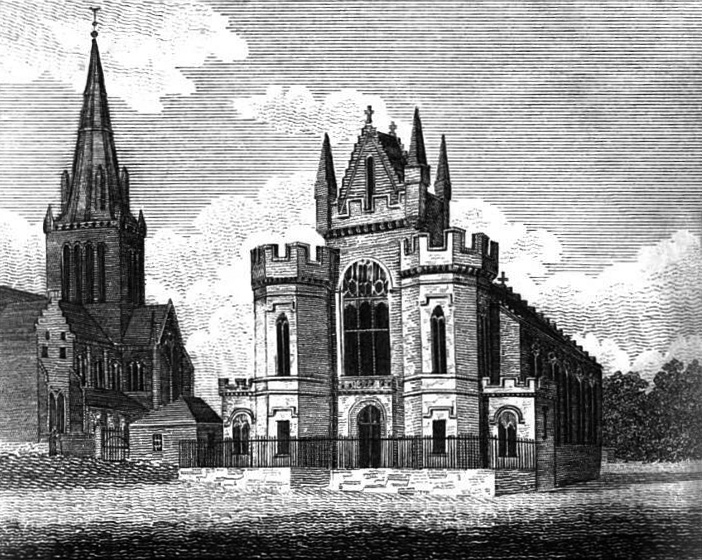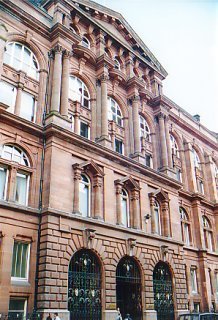|
Barony Church
Barony Hall, also known as Barony Church, is a red sandstone Victorian neo-Gothic-style building on Castle Street in the Townhead area of Glasgow, Scotland, near Glasgow Cathedral, Glasgow Royal Infirmary and the city's oldest surviving house, Provand's Lordship. The original or Old Barony Church was built as a part of the Barony Parish in Glasgow by architect, James Adams. It opened in 1799 and served ceremonial and other congregational purposes. The replacement for the old building was designed by J. J. Burnet & J. A. Campbell and raised in 1889, and incorporated architectural artifacts from the old church and a number of other relics. The New Barony Church was acquired by the University of Strathclyde in 1986. It was restored in 1989 and is now a ceremonial hall and events venue known as the Barony Hall. It is one of the few buildings in the area that survived the slum clearances of the 1950s and 1960s as part of the Townhead 'Comprehensive Development Area' (CDA). Histo ... [...More Info...] [...Related Items...] OR: [Wikipedia] [Google] [Baidu] |
University Of Strathclyde
The University of Strathclyde ( gd, Oilthigh Shrath Chluaidh) is a public research university located in Glasgow, Scotland. Founded in 1796 as the Andersonian Institute, it is Glasgow's second-oldest university, having received its royal charter in 1964 as the first technological university in the United Kingdom. Taking its name from the historic Kingdom of Strathclyde, it is Scotland's third-largest university by number of students, with students and staff from over 100 countries. The institution was named University of the Year 2012 by Times Higher Education and again in 2019, becoming the first university to receive this award twice. The annual income of the institution for 2019–20 was £334.8 million of which £81.2 million was from research grants and contracts, with an expenditure of £298.8 million.. History The university was founded in 1796 through the will of John Anderson, professor of Natural Philosophy at the University of Glasgow, who left i ... [...More Info...] [...Related Items...] OR: [Wikipedia] [Google] [Baidu] |
Maryhill
Maryhill ( gd, Cnoc Màiri) is an area of the City of Glasgow in Scotland. Maryhill is a former burgh. Maryhill stretches over along Maryhill Road. The far north west of the area is served by Maryhill railway station. History Hew Hill, the Laird, or Lord, of Gairbraid, had no male heir and so he left his estate to his daughter, Mary Hill (1730-1809). She married Robert Graham of Dawsholm in 1763, but they had no income from trade or commerce and had to make what they could from the estate. They founded coalmines on the estate but they proved to be wet and unprofitable. On 8 March 1768 Parliament approved the cutting of the Forth and Clyde Canal through their estate, which provided some much-needed money. The canal reached the estate in 1775, but the canal company had run out of money and work stopped for eight years. The Government granted funds from forfeited Jacobite estates to start it again and the crossing of the River Kelvin became the focus for massive constructi ... [...More Info...] [...Related Items...] OR: [Wikipedia] [Google] [Baidu] |
Barony Hall, Strathclyde University
{{disambig ...
Barony may refer to: * Barony, the peerage, office of, or territory held by a baron * Barony, the title and land held in fealty by a feudal baron * Barony (county division), a type of administrative or geographical division in parts of the British Isles ** Barony (Ireland), a historical subdivision of the Irish counties * Barony (role-playing game), a 1990 tabletop RPG See also * Baronet * Baronage {{English Feudalism In England, the ''baronage'' was the collectively inclusive term denoting all members of the feudal nobility, as observed by the constitutional authority Edward Coke. It was replaced eventually by the term ''peerage''. Origi ... [...More Info...] [...Related Items...] OR: [Wikipedia] [Google] [Baidu] |
Royal Incorporation Of Architects In Scotland
The Royal Incorporation of Architects in Scotland (RIAS) is the professional body for architects in Scotland. History Previously the (lapsed) Architectural Institute of Scotland, it was re-founded in 1916 as the Incorporation of Architects in Scotland by architect Robert Rowand Anderson (1834–1921) from his sick bed. Anderson donated his Georgian townhouse in Edinburgh to be used as its home, where the organisation remains to this day. It was given its first Royal charter in 1922, followed by a second in 1929. Organisation The RIAS comprises six chapters across Scotland: *Aberdeen Society of Architects (ASA) * Dundee Institute of Architects (DIA) *Edinburgh Architectural Association (EAA) *Glasgow Institute of Architects (GIA) *Inverness Architectural Association (IAA) *Stirling Society of Architects (SSA) Associate membership is available to anyone registered as an architect who lives and works in Scotland. The Incorporation is an independent body representing Architects ... [...More Info...] [...Related Items...] OR: [Wikipedia] [Google] [Baidu] |
Glasgow Civic Trust
Glasgow ( ; sco, Glesca or ; gd, Glaschu ) is the most populous city in Scotland and the fourth-most populous city in the United Kingdom, as well as being the 27th largest city by population in Europe. In 2020, it had an estimated population of 635,640. Straddling the border between historic Lanarkshire and Renfrewshire, the city now forms the Glasgow City Council area, one of the 32 council areas of Scotland, and is governed by Glasgow City Council. It is situated on the River Clyde in the country's West Central Lowlands. Glasgow has the largest economy in Scotland and the third-highest GDP per capita of any city in the UK. Glasgow's major cultural institutions – the Burrell Collection, Kelvingrove Art Gallery and Museum, the Royal Conservatoire of Scotland, the Royal Scottish National Orchestra, Scottish Ballet and Scottish Opera – enjoy international reputations. The city was the European Capital of Culture in 1990 and is notable for its architecture, culture, ... [...More Info...] [...Related Items...] OR: [Wikipedia] [Google] [Baidu] |
UK Civic Trust
The United Kingdom of Great Britain and Northern Ireland, commonly known as the United Kingdom (UK) or Britain, is a country in Europe, off the north-western coast of the continental mainland. It comprises England, Scotland, Wales and Northern Ireland. The United Kingdom includes the island of Great Britain, the north-eastern part of the island of Ireland, and many smaller islands within the British Isles. Northern Ireland shares a land border with the Republic of Ireland; otherwise, the United Kingdom is surrounded by the Atlantic Ocean, the North Sea, the English Channel, the Celtic Sea and the Irish Sea. The total area of the United Kingdom is , with an estimated 2020 population of more than 67 million people. The United Kingdom has evolved from a series of annexations, unions and separations of constituent countries over several hundred years. The Treaty of Union between the Kingdom of England (which included Wales, annexed in 1542) and the Kingdom of Scotland in 1707 ... [...More Info...] [...Related Items...] OR: [Wikipedia] [Google] [Baidu] |
Europa Nostra Award
Europa may refer to: Places * Europe * Europa (Roman province), a province within the Diocese of Thrace * Europa (Seville Metro), Seville, Spain; a station on the Seville Metro * Europa City, Paris, France; a planned development * Europa Cliffs, Alexander Island, Antarctica * Europa Island, a small island in the Mozambique Channel which is a possession of France * Europa Point, Gibraltar; the southernmost point of Gibraltar * Europa Road, Gibraltar * Plaça d'Europa, Barcelona, Spain; a square * Europa, Missouri, USA; a community Astronomical locations * Europa (moon), a moon of Jupiter * 52 Europa, an asteroid Buildings and structures * Europa building, the seat of the European Council and Council of the European Union in Brussels, Belgium * Europa Hotel (other) * Europa Hut, a Swiss mountain hut * Europa Tower, Vilnius, Lithuania Fictional locations * Europa, a fictional place in ''Valkyria Chronicles'' People * Europa of Macedon, the daughter of Philip II by his l ... [...More Info...] [...Related Items...] OR: [Wikipedia] [Google] [Baidu] |
Baroque
The Baroque (, ; ) is a style of architecture, music, dance, painting, sculpture, poetry, and other arts that flourished in Europe from the early 17th century until the 1750s. In the territories of the Spanish and Portuguese empires including the Iberian Peninsula it continued, together with new styles, until the first decade of the 19th century. It followed Renaissance art and Mannerism and preceded the Rococo (in the past often referred to as "late Baroque") and Neoclassical styles. It was encouraged by the Catholic Church as a means to counter the simplicity and austerity of Protestant architecture, art, and music, though Lutheran Baroque art developed in parts of Europe as well. The Baroque style used contrast, movement, exuberant detail, deep colour, grandeur, and surprise to achieve a sense of awe. The style began at the start of the 17th century in Rome, then spread rapidly to France, northern Italy, Spain, and Portugal, then to Austria, southern Germany, and Russia. B ... [...More Info...] [...Related Items...] OR: [Wikipedia] [Google] [Baidu] |
Maurice Taylor Organ
Maurice may refer to: People *Saint Maurice (died 287), Roman legionary and Christian martyr *Maurice (emperor) or Flavius Mauricius Tiberius Augustus (539–602), Byzantine emperor *Maurice (bishop of London) (died 1107), Lord Chancellor and Lord Keeper of England *Maurice of Carnoet (1117–1191), Breton abbot and saint *Maurice, Count of Oldenburg (fl. 1169–1211) *Maurice of Inchaffray (14th century), Scottish cleric who became a bishop *Maurice, Elector of Saxony (1521–1553), German Saxon nobleman *Maurice, Duke of Saxe-Lauenburg (1551–1612) *Maurice of Nassau, Prince of Orange (1567–1625), stadtholder of the Netherlands *Maurice, Landgrave of Hesse-Kassel or Maurice the Learned (1572–1632) *Maurice of Savoy (1593–1657), prince of Savoy and a cardinal *Maurice, Duke of Saxe-Zeitz (1619–1681) *Maurice of the Palatinate (1620–1652), Count Palatine of the Rhine *Maurice of the Netherlands (1843–1850), prince of Orange-Nassau *Maurice Chevalier (1888–1972), Fre ... [...More Info...] [...Related Items...] OR: [Wikipedia] [Google] [Baidu] |
Royal College Of Science And Technology
The Royal College of Science and Technology was a higher education college that existed in Glasgow, Scotland between 1887 and 1964, and is the predecessor institution of the University of Strathclyde. Its main building on George Street now serves as one of the major academic buildings of the University. History Originally the ''Glasgow and West of Scotland Technical College'', ''The Royal College of Science and Technology'' was formed in 1887. ''Glasgow and West of Scotland Technical College'' was formed through the amalgamation of ''Anderson's University'', the ''College of Science and Arts'', ''Allan Glen's Institution'', the ''Young Chair of Technical Chemistry'' and ''Atkinson's Institution''. Because of the ever-increasing number of students attending the college, larger premises became necessary. Work to expand the ''Glasgow and West of Scotland Technical College'' building began in 1903, taking nine years to complete. At that time, it was the largest single educational com ... [...More Info...] [...Related Items...] OR: [Wikipedia] [Google] [Baidu] |
Glasgow Herald
''The Herald'' is a Scottish broadsheet newspaper founded in 1783. ''The Herald'' is the longest running national newspaper in the world and is the eighth oldest daily paper in the world. The title was simplified from ''The Glasgow Herald'' in 1992. Following the closure of the ''Sunday Herald'', the ''Herald on Sunday'' was launched as a Sunday edition on 9 September 2018. History Founding The newspaper was founded by an Edinburgh-born printer called John Mennons in January 1783 as a weekly publication called the ''Glasgow Advertiser''. Mennons' first edition had a global scoop: news of the treaties of Versailles reached Mennons via the Lord Provost of Glasgow just as he was putting the paper together. War had ended with the American colonies, he revealed. ''The Herald'', therefore, is as old as the United States of America, give or take an hour or two. The story was, however, only carried on the back page. Mennons, using the larger of two fonts available to him, put it in th ... [...More Info...] [...Related Items...] OR: [Wikipedia] [Google] [Baidu] |





